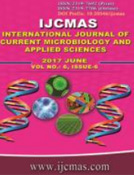


 National Academy of Agricultural Sciences (NAAS)
National Academy of Agricultural Sciences (NAAS)

|
PRINT ISSN : 2319-7692
Online ISSN : 2319-7706 Issues : 12 per year Publisher : Excellent Publishers Email : editorijcmas@gmail.com / submit@ijcmas.com Editor-in-chief: Dr.M.Prakash Index Copernicus ICV 2018: 95.39 NAAS RATING 2020: 5.38 |
The aim of this study was to isolate amylase-producing fungi, optimize the cultural conditions using solid state fermentation (SSF) and characterize the partially purified enzyme. Six fungal strains isolated from soil and decayed onion samples were screened for their ability to secrete amylase. Culture medium was optimized using One-factor-at-a-Time (OFAT) methodology under SSF. The crude enzyme was partially purified by ammonium sulphate precipitation and the effect of physicochemical parameters on the amylase was investigated. Out of the six fungal strains, isolate F3 showed highest amylase producing ability. Phylogenetic analysis based on partial sequence of the 18S rRNA gene classified F3 as Aspergillus niger DTO: H5. Maximum amylase production was achieved within 48 h of cultivation using 5 % (w/v) wheat bran. Optimal SSF conditions which favoured amylase production were: fermentation period 48 h, initial pH 6.0, initial temperature 30oC, substrate to moisture content ratio 1:5 and inoculum size 1.3x1010 spores/ml. Crude amylase was partially purified by 80% ammonium sulphate saturation. The enzyme was purified 3.77-fold with specific activity of 36.65 U/mg and percentage yield of 90.53%. Optimum enzyme activity was noticed at 50oC and pH 4.0. Ca2+ had the highest stimulatory effect while Hg2+ significantly (p< 0.05) inhibited the enzyme activity. Presence of Mg2+, Na+ and Fe2+ increased the amylase activity while Cu2+ and Zn2+ were slightly inhibitory. This study showed that the fungus could utilize cost effective substrates (wheat bran) for amylase production and could be a promising source of the enzyme for allied and biotechnological industries.
 |
 |
 |
 |
 |